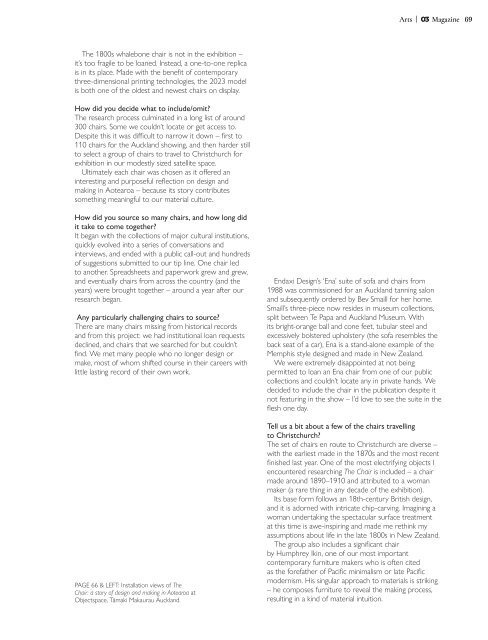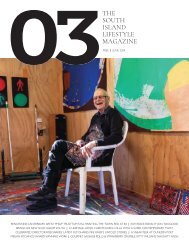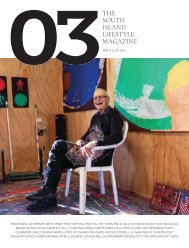Create successful ePaper yourself
Turn your PDF publications into a flip-book with our unique Google optimized e-Paper software.
Arts | <strong>Magazine</strong> 69<br />
The 1800s whalebone chair is not in the exhibition –<br />
it’s too fragile to be loaned. Instead, a one-to-one replica<br />
is in its place. Made with the benefit of contemporary<br />
three-dimensional printing technologies, the 2023 model<br />
is both one of the oldest and newest chairs on display.<br />
How did you decide what to include/omit?<br />
The research process culminated in a long list of around<br />
300 chairs. Some we couldn’t locate or get access to.<br />
Despite this it was difficult to narrow it down – first to<br />
110 chairs for the Auckland showing, and then harder still<br />
to select a group of chairs to travel to Christchurch for<br />
exhibition in our modestly sized satellite space.<br />
Ultimately each chair was chosen as it offered an<br />
interesting and purposeful reflection on design and<br />
making in Aotearoa – because its story contributes<br />
something meaningful to our material culture.<br />
How did you source so many chairs, and how long did<br />
it take to come together?<br />
It began with the collections of major cultural institutions,<br />
quickly evolved into a series of conversations and<br />
interviews, and ended with a public call-out and hundreds<br />
of suggestions submitted to our tip line. One chair led<br />
to another. Spreadsheets and paperwork grew and grew,<br />
and eventually chairs from across the country (and the<br />
years) were brought together – around a year after our<br />
research began.<br />
Any particularly challenging chairs to source?<br />
There are many chairs missing from historical records<br />
and from this project: we had institutional loan requests<br />
declined, and chairs that we searched for but couldn’t<br />
find. We met many people who no longer design or<br />
make, most of whom shifted course in their careers with<br />
little lasting record of their own work.<br />
PAGE 66 & LEFT: Installation views of The<br />
Chair: a story of design and making in Aotearoa at<br />
Objectspace, Tāmaki Makaurau Auckland.<br />
Endaxi Design’s ‘Ena’ suite of sofa and chairs from<br />
1988 was commissioned for an Auckland tanning salon<br />
and subsequently ordered by Bev Smaill for her home.<br />
Smaill’s three-piece now resides in museum collections,<br />
split between Te Papa and Auckland Museum. With<br />
its bright-orange ball and cone feet, tubular steel and<br />
excessively bolstered upholstery (the sofa resembles the<br />
back seat of a car), Ena is a stand-alone example of the<br />
Memphis style designed and made in New Zealand.<br />
We were extremely disappointed at not being<br />
permitted to loan an Ena chair from one of our public<br />
collections and couldn’t locate any in private hands. We<br />
decided to include the chair in the publication despite it<br />
not featuring in the show – I’d love to see the suite in the<br />
flesh one day.<br />
Tell us a bit about a few of the chairs travelling<br />
to Christchurch?<br />
The set of chairs en route to Christchurch are diverse –<br />
with the earliest made in the 1870s and the most recent<br />
finished last year. One of the most electrifying objects I<br />
encountered researching The Chair is included – a chair<br />
made around 1890–1910 and attributed to a woman<br />
maker (a rare thing in any decade of the exhibition).<br />
Its base form follows an 18th-century British design,<br />
and it is adorned with intricate chip-carving. Imagining a<br />
woman undertaking the spectacular surface treatment<br />
at this time is awe-inspiring and made me rethink my<br />
assumptions about life in the late 1800s in New Zealand.<br />
The group also includes a significant chair<br />
by Humphrey Ikin, one of our most important<br />
contemporary furniture makers who is often cited<br />
as the forefather of Pacific minimalism or late Pacific<br />
modernism. His singular approach to materials is striking<br />
– he composes furniture to reveal the making process,<br />
resulting in a kind of material intuition.


















